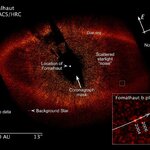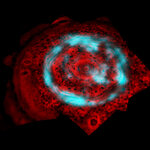Space
The Universal Declaration of Human Rights (UDHR) celebrates its 60th anniversary this year. As part of the commemoration of this event, the space shuttle Endeavour brought a version of it up to the International Space Station 15th November 2008.
Credit: NASA/JSCThe Universal Declaration of Human Rights will reside in the European Columbus laboratory of the space station.
Credit: ESA/NASAA view of the European Columbus laboratory installed in its new home on the International Space Station.When you read science sites and perhaps generally about space in media, you get the impression space…

Astronomers have taken snapshots of a multi-planet solar system much like ours orbiting another star, for the first time.
The new solar system orbits a dusty young star named HR 8799, which is 140 light years away and about 1.5 times the size of our sun. Three planets, roughly 10, 10 and 7 times the mass of Jupiter, orbit the star. The size of the planets decreases with distance from the parent star, much like the giant planets do in our system.
And there may be more planets out there, but scientists say they just haven't seen them yet.
HR 8799. Near-infrared false-color image taken with the…

Estimated to be no more than three times Jupiter's mass, the planet, called Fomalhaut b, orbits the bright southern star Fomalhaut, located 25 light-years away in the constellation Piscis Austrinus (the Southern Fish). Fomalhaut has been a candidate for planet hunting ever since an excess of dust was discovered around the star in the early 1980s by the US- UK-Dutch Infrared Astronomy Satellite (IRAS).
In 2004, the coronagraph in the High Resolution Camera on Hubble's Advanced Camera for Surveys produced the first-ever resolved visible light image of a large dust belt surrounding…

An infrared camera aboard NASA's Cassini spacecraft has discovered a unique aurora lighting up Saturn's polar cap. The mysterious new aurora is unlike any other known in our solar system.
"We've never seen an aurora like this elsewhere," said Tom Stallard, an RCUK Academic Fellow working with Cassini data at the University of Leicester. Stallard is lead author of a paper released today in the British journal Nature. "It's not just a ring of aurorae like those we've seen at Jupiter or Earth. This one covers an enormous area across the pole. Our current ideas on what forms Saturn's…

Illustrating the power of submillimetre-wavelength astronomy, an APEX image reveals how an expanding bubble of ionised gas about ten light-years across is causing the surrounding material to collapse into dense clumps that are the birthplaces of new stars. Submillimetre light is the key to revealing some of the coldest material in the Universe, such as these cold, dense clouds.
The region, called RCW120, is about 4200 light years from Earth, towards the constellation of Scorpius. A hot, massive star in its centre is emitting huge amounts of ultraviolet radiation, which ionises the surrounding…

Planet formation, as we all know (and don't know), is chaotic. It is like a lorenz Attractor constructable in computational astrophysics labs. When I was working on my astronomy project at Harvard this summer, I realized that there was a way to zoom into this complex, utterly random phenomenon to get a glimpse of the precise conditions of the proto-planetary disk as it evolved into the 'solar system'.
So what is that 'way' anyway?
According to the widely lauded sequential accretion theory, planet formation occurs in steps - and is governed by simple laws of physics: gravity pulls the disk…

Anyone who has wondered what it might be like to dive into a pool of millions of distant galaxies of different shapes and colours, will enjoy the latest image released by ESO. Obtained in part with the Very Large Telescope, the image is the deepest ground-based U-band image of the Universe ever obtained. It contains more than 27 million pixels and is the result of 55 hours of observations with the VIMOS instrument.
This uniquely beautiful patchwork image, with its myriad of brightly coloured galaxies, shows the Chandra Deep Field South (CDF-S), arguably the most observed and best studied…

NASA's Galaxy Evolution Explorer has lifted the veil off a ghost known to haunt the local universe, providing new insight into the formation and evolution of galaxies.
The eerie creature, called NGC 404, is a type of galaxy known as "lenticular." Lenticular galaxies are disk-shaped, with little ongoing star formation and no spiral arms. NGC 404 is the nearest example of a lenticular galaxy, and therefore of great interest. But it lies hidden in the glare from a red giant star called Mirach. For this reason, NGC 404 became known to astronomers as the "Ghost of Mirach."
When the…
Just last month, Hubble Space Telescope's main instruments were idled by a computer failure, but not to worry, thanks to NASA engineers, who successfully transferred the work of the failed science data downlink computer to a backup system, Hubble is up and running just a couple of days after the orbiting observatory was brought back online.
This image of two interacting galaxies, called Arp 147, was captured by Hubble's prime working camera, the Wide Field Planetary Camera 2 (WFPC2). Arp 147 appears in the Arp Atlas of Peculiar Galaxies, compiled by Halton Arp in the 1960s. This picture was…

The NASA/ESA Hubble Space Telescope is back in business with a snapshot of the fascinating galaxy pair Arp 147. The science operations were resumed on 25 October 2008, four weeks after a problem with the science data formatter took the spacecraft into safe mode.
On Sunday 28 September 2008, the NASA/ESA Hubble Space Telescope automatically entered safe mode when errors were detected in the Control Unit/Science Data Formatter-Side A. This component is essential for the storage and transmission of data from the telescope's science instruments back to Earth. The component was reactivated on…